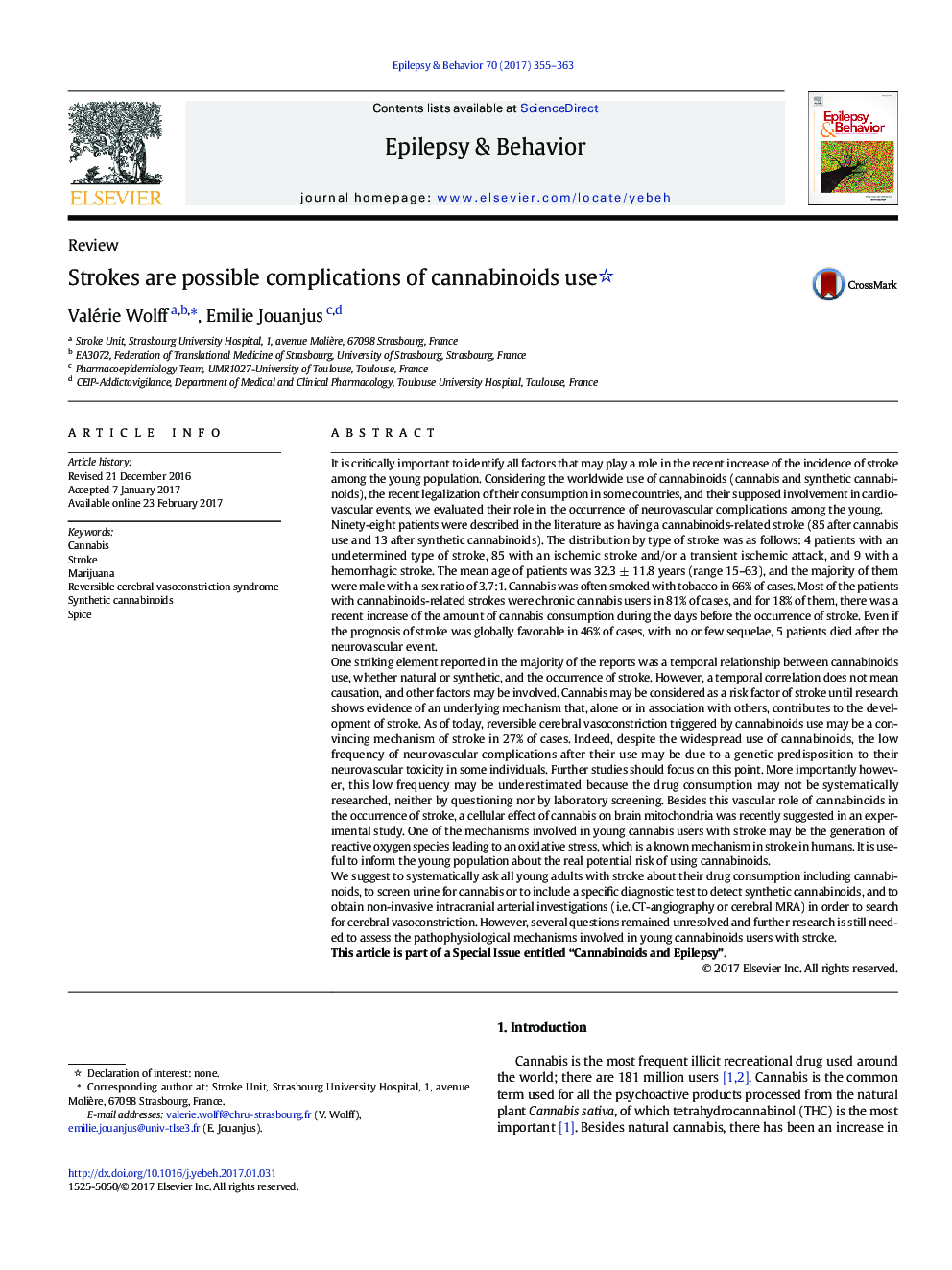| کد مقاله | کد نشریه | سال انتشار | مقاله انگلیسی | نسخه تمام متن |
|---|---|---|---|---|
| 5627994 | 1579822 | 2017 | 9 صفحه PDF | دانلود رایگان |
- Ninety-eight patients were described as having cannabinoids-related strokes.
- There is a temporal relationship between cannabinoids and the occurrence of stroke.
- Reversible vasoconstriction may be a mechanism of stroke in cannabinoids users.
- Researches are needed to assess the pathophysiology of cannabinoids-related strokes.
It is critically important to identify all factors that may play a role in the recent increase of the incidence of stroke among the young population. Considering the worldwide use of cannabinoids (cannabis and synthetic cannabinoids), the recent legalization of their consumption in some countries, and their supposed involvement in cardiovascular events, we evaluated their role in the occurrence of neurovascular complications among the young.Ninety-eight patients were described in the literature as having a cannabinoids-related stroke (85 after cannabis use and 13 after synthetic cannabinoids). The distribution by type of stroke was as follows: 4 patients with an undetermined type of stroke, 85 with an ischemic stroke and/or a transient ischemic attack, and 9 with a hemorrhagic stroke. The mean age of patients was 32.3 ± 11.8 years (range 15-63), and the majority of them were male with a sex ratio of 3.7:1. Cannabis was often smoked with tobacco in 66% of cases. Most of the patients with cannabinoids-related strokes were chronic cannabis users in 81% of cases, and for 18% of them, there was a recent increase of the amount of cannabis consumption during the days before the occurrence of stroke. Even if the prognosis of stroke was globally favorable in 46% of cases, with no or few sequelae, 5 patients died after the neurovascular event.One striking element reported in the majority of the reports was a temporal relationship between cannabinoids use, whether natural or synthetic, and the occurrence of stroke. However, a temporal correlation does not mean causation, and other factors may be involved. Cannabis may be considered as a risk factor of stroke until research shows evidence of an underlying mechanism that, alone or in association with others, contributes to the development of stroke. As of today, reversible cerebral vasoconstriction triggered by cannabinoids use may be a convincing mechanism of stroke in 27% of cases. Indeed, despite the widespread use of cannabinoids, the low frequency of neurovascular complications after their use may be due to a genetic predisposition to their neurovascular toxicity in some individuals. Further studies should focus on this point. More importantly however, this low frequency may be underestimated because the drug consumption may not be systematically researched, neither by questioning nor by laboratory screening. Besides this vascular role of cannabinoids in the occurrence of stroke, a cellular effect of cannabis on brain mitochondria was recently suggested in an experimental study. One of the mechanisms involved in young cannabis users with stroke may be the generation of reactive oxygen species leading to an oxidative stress, which is a known mechanism in stroke in humans. It is useful to inform the young population about the real potential risk of using cannabinoids.We suggest to systematically ask all young adults with stroke about their drug consumption including cannabinoids, to screen urine for cannabis or to include a specific diagnostic test to detect synthetic cannabinoids, and to obtain non-invasive intracranial arterial investigations (i.e. CT-angiography or cerebral MRA) in order to search for cerebral vasoconstriction. However, several questions remained unresolved and further research is still needed to assess the pathophysiological mechanisms involved in young cannabinoids users with stroke. This article is part of a Special Issue entitled “Cannabinoids and Epilepsy”.
Journal: Epilepsy & Behavior - Volume 70, Part B, May 2017, Pages 355-363
